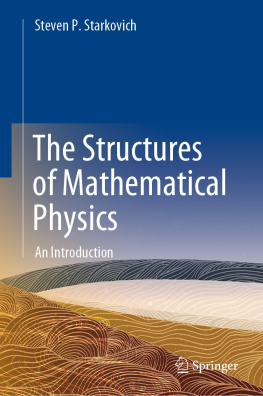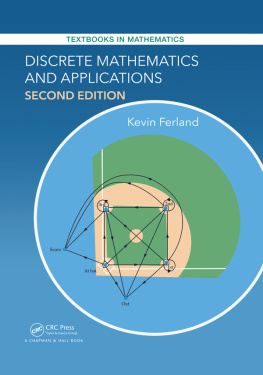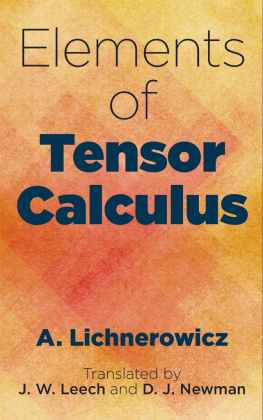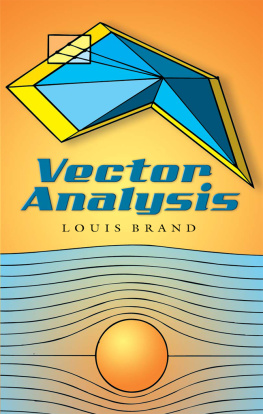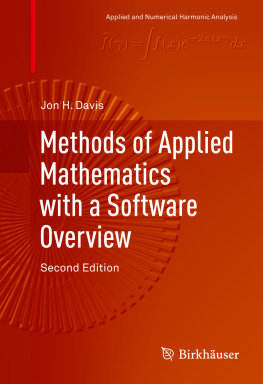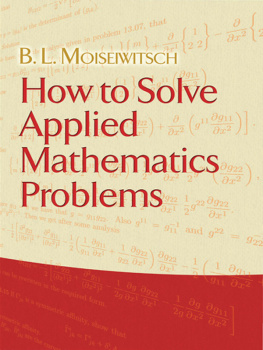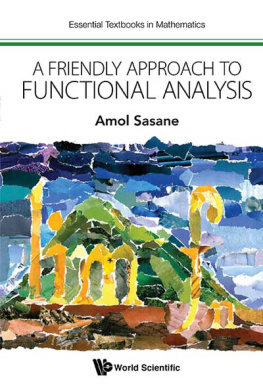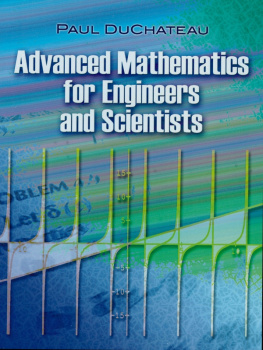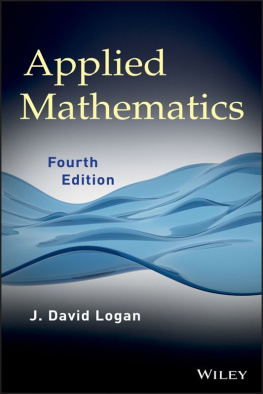Mehrzad Tabatabaian - Tensor Analysis for Engineers: Transformations-Mathematics-Applications
Here you can read online Mehrzad Tabatabaian - Tensor Analysis for Engineers: Transformations-Mathematics-Applications full text of the book (entire story) in english for free. Download pdf and epub, get meaning, cover and reviews about this ebook. publisher: Mercury Learning and Information, genre: Children. Description of the work, (preface) as well as reviews are available. Best literature library LitArk.com created for fans of good reading and offers a wide selection of genres:
Romance novel
Science fiction
Adventure
Detective
Science
History
Home and family
Prose
Art
Politics
Computer
Non-fiction
Religion
Business
Children
Humor
Choose a favorite category and find really read worthwhile books. Enjoy immersion in the world of imagination, feel the emotions of the characters or learn something new for yourself, make an fascinating discovery.
- Book:Tensor Analysis for Engineers: Transformations-Mathematics-Applications
- Author:
- Publisher:Mercury Learning and Information
- Genre:
- Rating:3 / 5
- Favourites:Add to favourites
- Your mark:
- 60
- 1
- 2
- 3
- 4
- 5
Tensor Analysis for Engineers: Transformations-Mathematics-Applications: summary, description and annotation
We offer to read an annotation, description, summary or preface (depends on what the author of the book "Tensor Analysis for Engineers: Transformations-Mathematics-Applications" wrote himself). If you haven't found the necessary information about the book — write in the comments, we will try to find it.
Tensor Analysis for Engineers: Transformations-Mathematics-Applications — read online for free the complete book (whole text) full work
Below is the text of the book, divided by pages. System saving the place of the last page read, allows you to conveniently read the book "Tensor Analysis for Engineers: Transformations-Mathematics-Applications" online for free, without having to search again every time where you left off. Put a bookmark, and you can go to the page where you finished reading at any time.
Font size:
Interval:
Bookmark:
TENSOR ANALYSIS
FOR ENGINEERS
Second Edition
LICENSE, DISCLAIMER OF LIABILITY, AND LIMITED WARRANTY
By purchasing or using this book (the Work), you agree that this license grants permission to use the contents contained herein, but does not give you the right of ownership to any of the textual content in the book or ownership to any of the information or products contained in it. This license does not permit uploading of the Work onto the Internet or on a network (of any kind) without the written consent of the Publisher. Duplication or dissemination of any text, code, simulations, images, etc. contained herein is limited to and subject to licensing terms for the respective products, and permission must be obtained from the Publisher or the owner of the content, etc., in order to reproduce or network any portion of the textual material (in any media) that is contained in the Work.
MERCURY LEARNING AND INFORMATION (MLI or the Publisher) and anyone involved in the creation, writing, or production of the companion disc, accompanying algorithms, code, or computer programs (the software), and any accompanying Web site or software of the Work, cannot and do not warrant the performance or results that might be obtained by using the contents of the Work. The author, developers, and the Publisher have used their best efforts to insure the accuracy and functionality of the textual material and/or programs contained in this package; we, however, make no warranty of any kind, express or implied, regarding the performance of these contents or programs. The Work is sold as is without warranty (except for defective materials used in manufacturing the book or due to faulty workmanship).
The author, developers, and the publisher of any accompanying content, and anyone involved in the composition, production, and manufacturing of this work will not be liable for damages of any kind arising out of the use of (or the inability to use) the algorithms, source code, computer programs, or textual material contained in this publication. This includes, but is not limited to, loss of revenue or profit, or other incidental, physical, or consequential damages arising out of the use of this Work.
The sole remedy in the event of a claim of any kind is expressly limited to replacement of the book, and only at the discretion of the Publisher. The use of implied warranty and certain exclusions vary from state to state, and might not apply to the purchaser of this product.
TENSOR ANALYSIS
FOR ENGINEERS
Transformations-Mathematics-Applications
Second Edition
Mehrzad Tabatabaian, PhD, PEng

MERCURY LEARNING AND INFORMATION
Dulles, Virginia
Boston, Massachusetts
New Delhi
Copyright 2021 by MERCURY LEARNING AND INFORMATION LLC. All rights reserved.
This publication, portions of it, or any accompanying software may not be reproduced in any way, stored in a retrieval system of any type, or transmitted by any means, media, electronic display or mechanical display, including, but not limited to, photocopy, recording, Internet postings, or scanning, without prior permission in writing from the publisher.
Publisher: David Pallai
MERCURY LEARNING AND INFORMATION
22841 Quicksilver Drive
Dulles, VA 20166
www.merclearning.com
(800) 232-0223
M. Tabatabaian. Tensor Analysis for Engineers: Transformations-Mathematics-Applications, Second Edition.
ISBN: 978-1-68392-601-6
The publisher recognizes and respects all marks used by companies, manufacturers, and developers as a means to distinguish their products. All brand names and product names mentioned in this book are trademarks or service marks of their respective companies. Any omission or misuse (of any kind) of service marks or trademarks, etc. is not an attempt to infringe on the property of others.
Library of Congress Control Number: 2020946631
202122321 This book is printed on acid-free paper in the United States of America.
Our titles are available for adoption, license, or bulk purchase by institutions, corporations, etc. For additional information, please contact the Customer Service Dept. at 800-232-0223(toll free).
All of our titles are available in digital format at www.academiccourseware.com and other digital vendors. The sole obligation of MERCURY LEARNING AND INFORMATION to the purchaser is to replace the book, based on defective materials or faulty workmanship, but not based on the operation or functionality of the product.
To my teachers and mentors
for their invaluable transfer of knowledge and direction.
CONTENTS
PREFACE
This is the second edition of the published textbook: Tensor Analysis for Engineers. In this edition, we expand the content on the rigid body rotation and Cartesian tensors by including Euler angles and quaternions methods. In addition to the rotation matrix method, presented in the first edition and included in this edition, we collect all three methods in this volume of the textbook. In this edition, the quaternions and their algebraic calculation rules are presented. We also discuss the active and passive rotations and present several worked-out examples using the Euler angles and quaternions methods applications and their interrelations. The problem of gimbal lock is also analyzed and presented with detailed worked out examples. Additional references have been included in the second edition.
In engineering and science, physical quantities are often represented by mathematical functions, namely tensors. Examples include temperature, pressure, force, mechanical stress, electric/magnetic fields, velocity, enthalpy, entropy, etc. In turn, tensors are categorized based on their rank, i.e. rank zero, one, and so forth. The so-called scalar quantities (e.g., temperature) are tensors of rank zero. Likewise, velocity and force are tensors of rank one and mechanical stress and gradient of velocity are tensors of rank two. In Euclidean space, which could be of dimension N = 3, 4, ..., we can define several coordinate systems for our calculation and measurement of physical quantities. For example, in a 3D space, we can have Cartesian, cylindrical, and spherical coordinate systems. In general, we prefer defining a coordinate system whose coordinate surfaces (where one of the coordinate variables is invariant or remains constant) match to the physical problem geometry at hand. This enables us to easily define the boundary conditions of the physical problem to the related governing equations, written in terms of the selected coordinate system. This action requires transformation of the tensor quantities and their related derivatives (e.g., gradient, curl, divergence) from Cartesian to the selected coordinate system or vice versa. The topic of tensor analysis (also referred to as tensor calculus or Riccis calculus since originally developed by Ricci, 18351925, [1], [2]), is mainly engaged with the definition of tensor-like quantities and their transformation among coordinate systems and others. The topic provides a set of mathematical tools which enables users to perform transformation and calculations of tensors for any well-defined coordinate systems in a systematic wayit is a machine. The merit of tensor analysis is to provide a systematic mathematical formulation to derive the general form of the governing equations for arbitrary coordinate systems.
In this book, we aim to provide engineers and applied scientists the tools and techniques of tensor analysis for applications in practical problem solving and analysis activities. The geometry is limited to the Euclidean space/geometry, where the Pythagorean Theorem applies, with well-defined Cartesian coordinate systems as the reference. We discuss quantities defined in curvilinear coordinate systems, like cylindrical, spherical, parabolic, etc., and present several examples and coordinates sketches with related calculations. In addition, we listed several worked-out examples for helping the readers with mastering the topics provided in the prior sections. A list of exercises is provided for further practice for readers.
Next pageFont size:
Interval:
Bookmark:
Similar books «Tensor Analysis for Engineers: Transformations-Mathematics-Applications»
Look at similar books to Tensor Analysis for Engineers: Transformations-Mathematics-Applications. We have selected literature similar in name and meaning in the hope of providing readers with more options to find new, interesting, not yet read works.
Discussion, reviews of the book Tensor Analysis for Engineers: Transformations-Mathematics-Applications and just readers' own opinions. Leave your comments, write what you think about the work, its meaning or the main characters. Specify what exactly you liked and what you didn't like, and why you think so.


